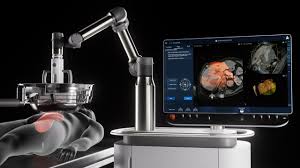When it comes to cancer treatment, innovation is the name of the game. The world is constantly searching for new, more effective ways to battle this deadly disease. Among the latest and most promising advancements is HistoSonics' sound beam-powered therapy for liver cancer. Recently, HistoSonics secured a whopping $102 million in funding to further develop this groundbreaking technology. Let's dive into what this means for the future of liver cancer treatment and why it’s such a big deal.
For More articles check www.healthpulse23.blogspot.com
The Power of Sound in Cancer Treatment
Before we get into the details of HistoSonics' recent achievement, let's take a moment to understand what makes their technology so special. Imagine a treatment that could target cancer cells with pinpoint accuracy, leaving surrounding healthy tissue unharmed. This is precisely what HistoSonics' sound beam-powered therapy, known as "histotripsy," aims to achieve.
Histotripsy uses focused ultrasound waves to mechanically disrupt cancer cells, effectively "blasting" them without the need for incisions, radiation, or chemicals. This non-invasive technique breaks down the cancerous tissue into tiny fragments that the body can naturally absorb and eliminate. It’s a method that holds incredible promise, especially for treating liver cancer, which can be notoriously difficult to manage with traditional therapies.
For More articles check www.healthpulse23.blogspot.com
Why Liver Cancer?
Liver cancer is one of the most challenging forms of cancer to treat. The liver is a vital organ responsible for various crucial functions, from detoxifying the blood to aiding digestion. However, its central role in the body's metabolic processes also makes it a common site for cancer to develop or metastasize.
Traditional treatments for liver cancer, such as surgery, chemotherapy, and radiation, can be effective but often come with significant drawbacks. Surgery is invasive and may not be an option for all patients, especially those with underlying health conditions. Chemotherapy and radiation can damage healthy cells along with cancerous ones, leading to severe side effects.
This is where histotripsy comes into play. By using sound waves to target only the cancerous cells, it offers a non-invasive alternative that could potentially minimize damage to healthy liver tissue. The result? A treatment that is not only effective but also safer and easier on the patient.
The $102 Million Boost: What It Means for HistoSonics
Securing $102 million in funding is no small feat, and it speaks volumes about the confidence investors have in HistoSonics and its technology. This influx of capital will allow the company to accelerate the development and commercialization of its histotripsy therapy, bringing it one step closer to being widely available to patients.
But what exactly will this funding be used for? Here’s a breakdown of some of the key areas HistoSonics is likely to focus on:
Clinical Trials: One of the most critical steps in bringing a new treatment to market is rigorous clinical testing. The funding will support ongoing and future clinical trials to evaluate the safety and effectiveness of histotripsy in treating liver cancer. These trials will provide the data needed to gain regulatory approval and ensure that the therapy is both safe and effective for patients.
Technological Advancements: While histotripsy is already a cutting-edge technology, there’s always room for improvement. The funding will allow HistoSonics to refine their equipment, making it even more precise and user-friendly. This could involve enhancing the imaging technology used to guide the sound beams or improving the software that controls the treatment process.
Market Expansion: Once histotripsy is approved for liver cancer, the next step will be to explore its potential in treating other types of cancer. The funding will help HistoSonics expand its research and development efforts, potentially opening the door to using sound beam therapy for other hard-to-treat cancers, such as pancreatic or brain cancer.
Patient Access: Finally, the funding will help HistoSonics ensure that once histotripsy is ready for market, it’s accessible to patients who need it. This could involve working with healthcare providers and insurance companies to integrate the treatment into existing care plans and make it affordable for patients.
The Future of Cancer Treatment: Why This Matters
So, why is this news about HistoSonics and their $102 million funding round so exciting? Simply put, it represents a significant step forward in the fight against liver cancer and cancer in general.
Traditional cancer treatments have come a long way, but they are far from perfect. Many come with severe side effects, long recovery times, and varying degrees of effectiveness. Histotripsy offers a new approach that could potentially change the way we think about cancer treatment. By using sound waves to target cancer cells with incredible precision, it has the potential to offer a less invasive, more effective treatment option with fewer side effects.
For patients with liver cancer, this could mean a better quality of life during treatment and a higher likelihood of beating the disease. But the implications go beyond just liver cancer. If histotripsy proves successful, it could pave the way for similar treatments for other types of cancer, revolutionizing the entire field of oncology.
For More articles check www.healthpulse23.blogspot.com
What’s Next for HistoSonics?
With $102 million in new funding, HistoSonics is well-positioned to push forward with its plans. The company will likely continue to focus on clinical trials to ensure that their histotripsy technology is ready for widespread use. If all goes well, we could see this treatment become available to liver cancer patients in the near future.
In addition to liver cancer, HistoSonics is likely to explore other applications for their technology. Given the versatility of sound wave therapy, it’s not hard to imagine a future where histotripsy is used to treat a variety of cancers and possibly other diseases.
For now, though, all eyes are on the ongoing trials and the results they will yield. If successful, HistoSonics could very well be on the brink of a major medical breakthrough.
Conclusion
The journey to finding better cancer treatments is a long and challenging one, but stories like HistoSonics’ show that we’re making real progress. The company’s sound beam-powered therapy represents a bold new approach to treating liver cancer, and the recent $102 million in funding is a testament to the promise this technology holds.
As HistoSonics continues to develop and refine their histotripsy technology, there’s a growing sense of optimism in the medical community. If successful, this treatment could change the landscape of cancer therapy, offering a safer, more effective option for patients worldwide.
In the meantime, we’ll be watching closely as HistoSonics moves forward with their trials and development. The future of liver cancer treatment—and perhaps cancer treatment as a whole—looks brighter than ever.






.png)
.jpeg)

.jfif)

.jpeg)
.jpeg)
0 Comments